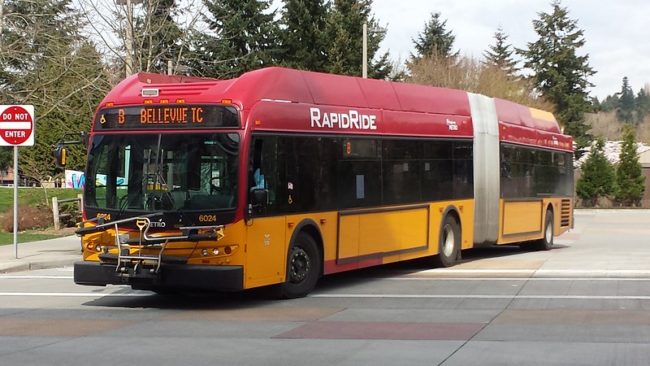Metro faces steep challenges in 2021
 RapidRide expansions may be delayed (image: Kris Leisten)
RapidRide expansions may be delayed (image: Kris Leisten)Last week, King County Metro General Manager Rob Gannon delivered a sobering assessment of Metro's challenges in returning to normal service. Funding from the CARES Act has back-filled most of the revenue declines for 2020, but massive shortfalls in fare and tax revenue lie ahead after that once-off money runs out.
Between foregone fares and lowered tax revenues, Metro expects a revenue shortfall this year between $240 and $265 million. That is mostly replaced by $243 million in CARES Act money that is being disbursed through the FTA. There are strings attached to what kind of spending can be supported through CARES Act dollars, but Metro anticipates the money will be completely or very nearly completely spent down in 2020.
Beyond that, the prospects for further federal aid are uncertain, and certainly will not be sustained at the rates in recent stimulus legislation. The revenue forecast from the King County budget office is for a reduction in sales tax alone of $397 million between 2020 and 2022, though budget director Dwight Dively indicated on May 5 that he expects the actual deficit to be somewhat worse.
 Current forecasts are for a recession much deeper than those in 2001 or 2008, with economic output remaining before pre-recession trends for many years (data: Congressional Budget Office & Federal Reserve. Graph by author)
Current forecasts are for a recession much deeper than those in 2001 or 2008, with economic output remaining before pre-recession trends for many years (data: Congressional Budget Office & Federal Reserve. Graph by author)Metro's operating budget for the 2021-2022 biennium was estimated at $2.05 billion before the COVID crisis. $950 million of that was to come from sales taxes, $411 million from fares, and another $409 million from service contracts with Sound Transit and Seattle.
So a revenue shortfall of several hundreds of millions, perhaps extending beyond 2022, will mean substantial service reductions.
Unlike the last recession, it's better offset by healthy reserves. The revenue stabilization reserve was created in 2011 to moderate swings in revenues and now stands at about $250 million, though it's not clear how far Metro would countenance spending that down. As then Metro GM Kevin Desmond described on this blog in 2014, the revenue stabilization targets were set to allow Metro to ride out a moderate recession lasting three to four years". It wasn't designed to fill shortfalls as deep or sustained as those now expected.
 Metro's robust reserves put the agency in a better position than it faced going into the last recession (table: Metro Transit Budget 2019-2020)
Metro's robust reserves put the agency in a better position than it faced going into the last recession (table: Metro Transit Budget 2019-2020)